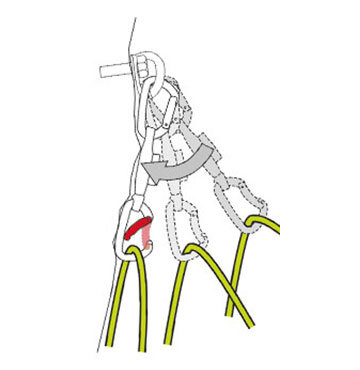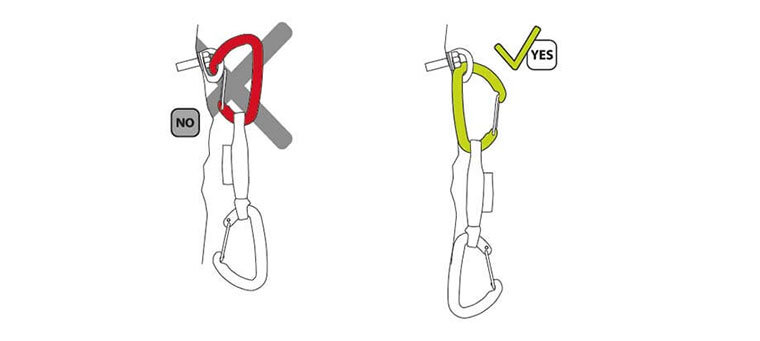Even the best carabiner can be a potential source of risk if it's not used properly. Here are the main carabiner associated risks and dangerous situations to avoid.

The whiplash effect (aka gate flutter) occurs when the back of a carabiner, i.e. the side opposite the gate, hits hard against a solid surface (for example a rock face). In the event of a fall, as the rope is pulled taught, the carabiner is often banged against the wall and shock loaded. Due to inertia the gate opens for a split second. It's easy to simulate the whiplash effect yourself. Simply bang the back of a normal carabiner against the edge of table or the back of your hand. You'll hear the clicking sound of the gate opening and closing, though you don't see it because it happens so quickly. This brief moment where the carabiner opens is potentially dangerous. If the carabiner is loaded at the exact moment when it is open, then it will have less than half its normal breaking strength compared to when it is closed. The high forces generated during a fall can, in certain circumstances, lead to the carabiner deforming. In the worst-case scenario the forces may be so large that the carabiner might break. As wire gate carabiners have less mass and lower inertia, they have less whiplash effect than carabiners with a solid gate (full gate).
Real protection against the whiplash effect is provided by an express sling in combination with our innovative PURE SLIDER Carabiner, which has an easy-to-open clasp.
CROSS-LOADING – HOW DOES IT HAPPEN?
Unfortunately, many climbers are unaware that a crossloaded carabiner has less than half the breaking strength than it has when loaded lengthwise. So how does crossloading occur? Carabiners can rotate in a bolt and come to rest on the spine; they become cross-loaded.
This often happens during traverses. D-shaped carabiners are designed to slip back into the correct position. However, this is only possible if the loop in the quickdraw sling is wide enough to ensure that the carabiner can move freely. Again, this is why it's important to always clip the right side of the quickdraw in the bolt. In addition, avoid cross-loading when attaching your belay device to your harness, belaying, lowering and abseiling. Locking carabiners are generally used for these activities. To prevent cross-loading, some HMS carabiners have an internal positioning element for the tie-in point. This prevents the carabiner slipping and ensures that it always has correct orientation for maximum breaking strength.

LOADING OVER AN EDGE
Always avoid any possibility of a carabiner being loaded over an edge. If a bolt, peg or protection is badly positioned, this might lead to a carabiner being loaded directly over a rock edge. This can have drastic results. Our tip: Extend the quickdraw by using a sling. By extending with a sling through the bolt, pro etc. you can ensure that the carabiner hangs freely and away from any edges so that it will load lengthwise where it's strongest.

LOADING WITH GATE OPEN
Clip your bolts carefully. And take care when clipping a climbing rope or a sling in a carabiner. Always make sure that you've closed the carabiner properly so that it has maximum breaking strength. If a rope or sling gets caught on the carabiner nose or a bolt hangar prevents the gate from closing, the carabiner will have well under 50% of its normal breaking strength. In the event of extreme force, the carabiner might even bend or break. So always make sure that your carabiner is properly closed, even if you are forced to move quick.

ABRASION AND BURRS
As with all equipment, carabiners start to show signs of wear over time. Carabiners are personal protective equipment for mountain sports. As such, you should inspect them carefully. Direct contact with bolts, but also rope wear can cause sharp edges and burrs. These can damage your rope or even cause it to break. For this reason, stop using any carabiners with sharp edges or burrs immediately. In addition, carabiners with material that shows signs of abrasion are not as strong. Abrasion can have a significant effect on breaking strength.


Dirty carabiners are often difficult to handle. This can be potentially dangerous if they don't close properly. Clean and rinse your biners regularly with water and if necessary lubricate the gate locking mechanism with an acid-free oil. Always wipe off any excess oil. Please note: quickdraw slings and webbing must never come into contact with oil.

During high-alpine mountaineering or when ice climbing, your gear is subjected to extreme conditions. It's not unheard of for carabiners to freeze up completely. This might cause you a serious problem. Wire gates are less likely to freeze, so they are more suitable for use in such conditions.

There are plenty of interesting climbing areas on the coastlines. Some of these routes involve tidal locations that literally start next to crashing waves. Bear in mind that salt water is a carabiner's worst enemy. Salt water attacks and corrodes metal. Always wash and rinse carabinersthat come into contact with sea water with plenty of clean water. You might also want to lubricate the gate closure mechanism once you've washed it. Use an acid-free oil (note: make sure your quickdraw slings and webbing don't come into contact with oil).
